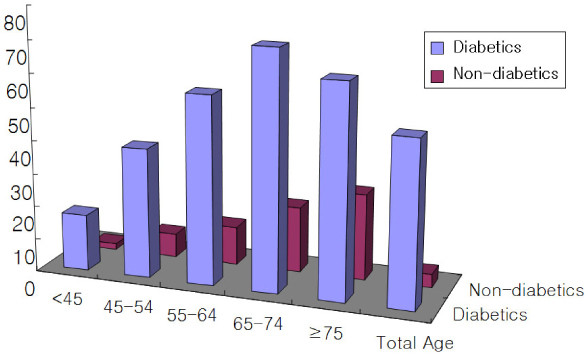Current Status of Diabetic Foot in Korean Patients Using National Health Insurance Database
- Affiliations
-
- 1Task Force Team for Basic Statistical Study of Korean Diabetes Mellitus of Korean Diabetes Association, Korea.
- 2Department of Research, Health Insurance Review Agency, Korea.
- 3Department of Internal Medicine, Wonju College of Medicine, Yonsei University, Korea.
- 4Department of Endocrinology and Metabolism, Ajou University School of Medicine, Korea.
- 5Department of Internal Medicine, College of Medicine, Eulji University, Korea.
- 6Department of Internal, Pochon CHA University, Korea.
- 7Department of Internal Medicine, Pusan Paik Hospital, Inje College of Medicine, Korea.
- 8Division of Endocrinology and Metabolism, Department of Internal Medicine, Korea University, Korea.
- 9Department of Internal Medicine, The Catholic University of Korea, Korea.
- 10Department of Internal Medicine, Yonsei University College of Medicine, Korea.
- 11Division of Endocrinology and Metabolism, Ewha Womans University College of Medicine, Korea.
- 12Department of Biostatistics, College of Medicine, Korea University, Korea.
- 13Department of Endocrinology, Gachon University of Science and Medicine, Gil Medical Center, Korea.
- KMID: 2008267
- DOI: http://doi.org/10.4093/jkda.2006.30.5.372
Abstract
-
BACKGROUND: Foot ulcer diseases are more prevalent in diabetic patients than that those of non-diabetic patients. Several reports showed the risk of amputation and the medical cost were increased when foot ulcer developed. Therefore, strict glycemic control from the initial period of diabetes is necessary. Since there is no enough epidemiologic data, large scaled studies for medical and economic consequences about diabetic foot ulcer are needed.
METHODS
This study was based on health insurance claims submitted to the National Health Insurance Review Agency during the period from December 1994 through December 2002. We investigated the incidence and medical cost of foot disorders in Korean population using the disease-classification codes on the health insurance claim forms.
RESULTS
The incidences of foot disorders (per 100,000 of population) were 49.7 for amputations, 99.7 for ulcers, and 1,051 for injuries in diabetic patients, and 4.2 for amputations, 10.3 for ulcers, and 943 for injuries in non-diabetic patients. Relative risk of the incidences of foot amputation, ulcer, and injury in diabetic patients comparing with non-diabetic patients were 11.7, 9.7, and 1.1, respectively. Total medical costs (per capita) of foot amputation, ulcer, and injury in diabetic patients were 2.0, 1.7, and 2.1 times higher, respectively, than those of non-diabetic patients. Mean hospital stay of foot amputation, ulcer, and injury in diabetic patients were 1.6, 1.3, and 1.7 times more, respectively, than those of non-diabetic patients.
CONCLUSION
In diabetic patients, the incidences of foot amputation and ulcer are higher than those of non-diabetic patients. To reduce those incidences, we need to early strict glycemic control as well as government based management.
Keyword
MeSH Terms
Figure
Cited by 6 articles
-
Regional Variation in the Incidence of Diabetes-Related Lower Limb Amputations and Its Relationship with the Regional Factors
Sung Hun Won, Jahyung Kim, Dong-Il Chun, Young Yi, Suyeon Park, Kwang-Young Jung, Gun-Hyun Park, Jaeho Cho
J Korean Foot Ankle Soc. 2019;23(3):121-130. doi: 10.14193/jkfas.2019.23.3.121.Diagnosis and Management of Diabetic Foot
Chang Won Lee
J Korean Diabetes. 2018;19(3):168-174. doi: 10.4093/jkd.2018.19.3.168.Microbiology and Antimicrobial Therapy for Diabetic Foot Infections
Ki Tae Kwon, David G. Armstrong
Infect Chemother. 2018;50(1):11-20. doi: 10.3947/ic.2018.50.1.11.Epidemiology of Diabetic Foot Disease
Kyu Jeung Ahn
J Korean Diabetes. 2011;12(2):72-75. doi: 10.4093/jkd.2011.12.2.72.Diabetic Foot: Past and Present
Ji Ho Lee, Choon Hee Chung
J Korean Diabetes. 2011;12(2):69-71. doi: 10.4093/jkd.2011.12.2.69.Advanced Glycation End Products and Management of Diabetes Diet
Hyun-Sun Lee
J Korean Diabetes. 2013;14(2):90-93. doi: 10.4093/jkd.2013.14.2.90.
Reference
-
2. Boulton AJM. Pickup JC, editor. Foot problems in patients with diabetes mellitus. 1997. Vol. 2. Oxford, U.K: Williams Gm Blackwell Science;1–20.3. Most RS, Sinnock P. The epidemiology of lower extremity amputation in diabetic individuals. Diabetes Care. 1983. 6:87–91.4. Siitonen OI, Niskanen LK, Laakso M, Siitonen JT, Pyorala K. Lower-extremity amputations in diabetic and nondiabetic patients. A population-based study in eastern Finland. Diabetes Care. 1993. 16:16–20.5. Boyko EJ, Ahroni JH, Smith DG, Davignon D. Increased mortality associated with diabetic foot ulcer. Diabet Med. 1996. 13:967–972.6. Rowbotham JL, Gibbons GW, Kozak GP. The diabetic foot. Kozak's Clinical Diabetes Mellitus. 1982. Philadelphia: W.B. Saunders Co;215–228.9. Ollendorf D, Kotsanos J, Wishner W, Friedman M, Cooper T, Bittoni M, Oster G. Potential economic benefits of lower-extremity amputation prevention strategies in diabetes. Diabetes Care. 1998. 21:1240–1245.10. Ramsey SD, Newton K, Blough D, McCulloch DK, Sandhu N, Reiber GE, Wagner EH. Incidences, outcomes, and cost of foot ulcers in patients with diabetes. Diabetes Care. 1999. 22:382–387.11. Harrington C, Corea J, Zagari M, Klitenic J. A cost analysis of diabetic lower extremity ulcers. Diabetes Care. 2000. 23:1333–1338.
- Full Text Links
- Actions
-
Cited
- CITED
-
- Close
- Share
- Similar articles
-
- Epidemiologic Characteristics of Diabetes Mellitus in Korea: Current Status of Diabetic Patients Using Korean Health Insurance Database
- Epidemiology of Diabetic Foot Disease
- Prevalence and Current Status of Treatment of Diabetic Foot in South Korea
- Current Trends in the Treatment of Diabetic Foot: Analysis of the Korean Foot and Ankle Society (KFAS) Member Survey
- Prevention and Education for Diabetic Foot


